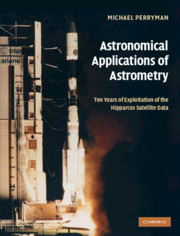Book contents
- Frontmatter
- Contents
- Preface
- 1 The Hipparcos and Tycho Catalogues
- 2 Derived catalogues and applications
- 3 Double and multiple stars
- 4 Photometry and variability
- 5 Luminosity calibration and distance scale
- 6 Open clusters, groups and associations
- 7 Stellar structure and evolution
- 8 Specific stellar types and the ISM
- 9 Structure of the Galaxy
- 10 Solar System and exoplanets
- Appendix A Numerical quantities
- Appendix B Acronyms
- Appendix C Author gallery
- Index of first authors
- Subject index
1 - The Hipparcos and Tycho Catalogues
Published online by Cambridge University Press: 23 November 2009
- Frontmatter
- Contents
- Preface
- 1 The Hipparcos and Tycho Catalogues
- 2 Derived catalogues and applications
- 3 Double and multiple stars
- 4 Photometry and variability
- 5 Luminosity calibration and distance scale
- 6 Open clusters, groups and associations
- 7 Stellar structure and evolution
- 8 Specific stellar types and the ISM
- 9 Structure of the Galaxy
- 10 Solar System and exoplanets
- Appendix A Numerical quantities
- Appendix B Acronyms
- Appendix C Author gallery
- Index of first authors
- Subject index
Summary
Overview
This chapter describes various aspects of the Hipparcos and Tycho Catalogues useful for understanding the scientific exploitation considered in subsequent chapters. It describes some of the satellite measurement principles relevant for an understanding of the catalogue contents; the published intermediate astrometry data; details of the adopted reference frame; basic transformations relevant to catalogue users; details of the Tycho 2 Catalogue construction; error assessment; and details of associated data such as radial velocities and cross-identifications.
The Hipparcos Catalogue contains 118 218 entries, corresponding to an average of some three stars per square degree over the entire sky. Median precision of the five astrometric parameters (Hp < 9 mag) exceeded the original mission goals, and are between 0.6–1.0 mas. Some 20 000 distances were determined to better than 10%, and 50 000 to better than 20%. The inferred ratio of external to standard errors is ˜1. 0–1. 2, and estimated systematic errors are below 0.1 mas. The number of solved or suspected double or multiple stars is 23 882. Photometric observations yielded multi-epoch photometry with a mean number of 110 observations per star, a median photometric precision (Hp < 9 mag) of 0.0015 mag, and 11 597 entries were identified as variable or possibly variable.
The Tycho Catalogue of just over 1 million stars was superseded in 2000 by the Tycho 2 Catalogue of some 2.5 million stars; both included two-colour photometry.
- Type
- Chapter
- Information
- Astronomical Applications of AstrometryTen Years of Exploitation of the Hipparcos Satellite Data, pp. 1 - 53Publisher: Cambridge University PressPrint publication year: 2008
- 14
- Cited by



